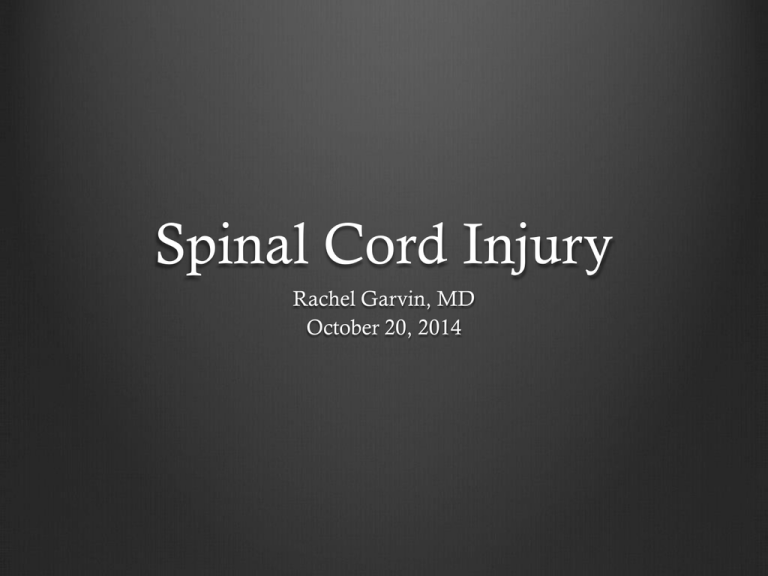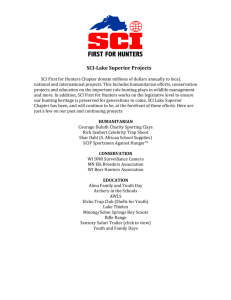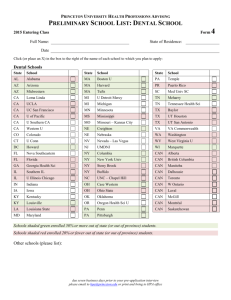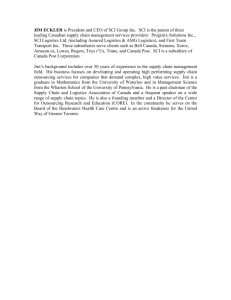SCI Overview
advertisement

Spinal Cord Injury Rachel Garvin, MD October 20, 2014 Diving Drunk 22 yo M presents as transfer from OSH Dove into shallow pool while intoxicated Patient amnestic to the event but currently GCS 15 VS on arrival to ED show HR 80, BP 89/55, RR 26 sats 95% on 2L NC Patient reports feeling “numb” all over Diving Drunk On neuro exam, sensation intact throughout Motor exam shows 4+ C5 bilaterally, otherwise 0 Absent rectal tone Complains of pain in neck MRI T1 MRI T2 Diving Drunk Orders written by neurosurgery: Admit to ICU Q1 neuro checks Continue c-collar at all times Log roll only Blood pressure control Lecture Objectives SCI statistics Review of Anatomy Pathophysiology Grading of SCI Mechanisms of SCI Respiratory Dysfunction Treatment of SCI Statistics Incidence of about 10-12,000 per year Young males 20-30 most commonly Mechanisms: MVC, falls, violence, sports Cervical spine most often injured over T/L/S combined Annual cost of SCI in the US >$7 billion Leading cause of death: pneumonia, PE, sepsis Anatomy Anatomy Ligaments Vascular Supply Vascular Supply Neurons Function Innervation Pathophysiology and Types of Injury Pathophysiology of SCI ASA and PSA usually intact Disrupted arteries constrict Gray matter venules get leaky Microhemorrhages occur in capillaries at gray/white border disruption of BSCB Within 30-60 minutes, gray matter clearly damaged 4 hours from injury mostly perfusion only to peripheral half of white matter On a cellular level. . . Autoregulation Blood flow in the SC is about ½ of brain Partial pressure of tissue oxygen same Animal studies show autoregulation between 40135mm HG Requires intact SNS and BSCB Change in Autoregulation Baroreflex Negative feedback High and low pressure systems Combines with pulmonary afferents and chemoreflex Decreased stretch decrease firing SNS activation Hypotension Related to Injury Level High T and C-spine injuries Loss of sympathetic outflow Relative hypovolemia How Common is Hypotension? Lehmann showed 68% with hypotension 71 consecutive patients with acute SCI 48 cervical; 31 complete Levi et al: complete cervical cord injury 5.5x more likely Nakao et al 45% had hypotension Retrospective study of 172 cervical SCI patients Half of the patients were complete quadriplegia Types of Injuries Axial Compression Compression or burst type fractures Least associated with SCI Flexion/Distraction or Hyperextension Usually an unstable injury Increased risk of SCI Rotational Almost always associated with SCI Spinal Cord Syndromes Knowing Your Anatomy Sensory and Motor Sensory: 0-2 0 = sensation absent 1 = sensation impaired 2 = sensation normal Motor: 0-5 0 = complete paralysis 1 = palpable or visible contraction 2 = active movement w/gravity eliminated 3 = active movement against gravity 4 = provides some resistance 5 = normal resistance Motor Scoring J Am Acad Orthop Surg 2009;17: 756-765 ASIA Scoring J Am Acad Orthop Surg 2009;17: 756-765 http://www.scientificspine.com/images/ASIA2006_front.jpg Central Cord Syndrome Most common type of incomplete SCI Trauma most common cause Older patient with spondylosis with hyperextension injury Often times no acute bony injury Central Cord Syndrome J Am Acad Orthop Surg 2009;17: 756-765 Diagnosis Complete neurologic assessment Pertinent history CT c-spine MRI Recovery Motor function returns caudad to cephalad Recovery usually less complete in UE Hand dysfunction is most common longer term disability Respiratory Dysfunction in SCI Muscles of Respiration http://bedahunmuh.files.wordpress.com/2010/05/muscles-of-respiration.jpg http://sig13perspectives.pubs.asha.org/data/Journals/ASHASASD/928 509/4.jpeg Active vs Passive http://www.buzzle.com/images/diagrams/human-body/diaphragm-movements.jpg http://flexiblelearning.auckland.ac.nz/medsci205/15/11/images/lungvolumes.jpg Complicated Pulmonary Dysfunction 84% of high c-spine with pulmonary complications Decreased lung expansion Impaired cough Impaired elastic recoil of diaphragm/lung Increased secretions Often pulmonary edema 5 year retrospective review (80 patients) Injury characteristics and outcomes of pts with SCI on MV 80% men Mean age 39 46% had cervical level injury Cervical injury pts had overall lower ISS Mean time to extubation 5.5 +/- 5.8 days Of 31 total failed wean attempts, 71% were cervical Failed Weaning and Extubation by Level of Injury Reasons for Extubation Failure Retrospective, single center study 1998-2011 256 patients Median ISS 17 SCI C1-T3 Readiness for extubation: RSBI <110 with “adequate airway and adequate oxygenation” Failure to meet criteria in 7-10 days = trach Trach 30% Treatment High Vt ventilation IPV Cough assist MIE Bronchodilators: ipratropium vs albuterol Sustained intubation/trach not always needed “The inspiratory and expiratory muscles can be completely supported noninvasively such that even patients with no ventilator or EPP/DP-free breathing ability (VFBA) and 0 ml of vital capacity (VC) have used noninvasive intermittent positive pressure ventilation (NIV) for decades, as long as 58 years for one of our patients…” Autonomic Dysreflexia Severity of AD Treatment Avoiding hypotension Spine stablization Early surgery vs late vs none Pulmonary support Early DVT prophylaxis NO STEROIDS Rehab Questions?






